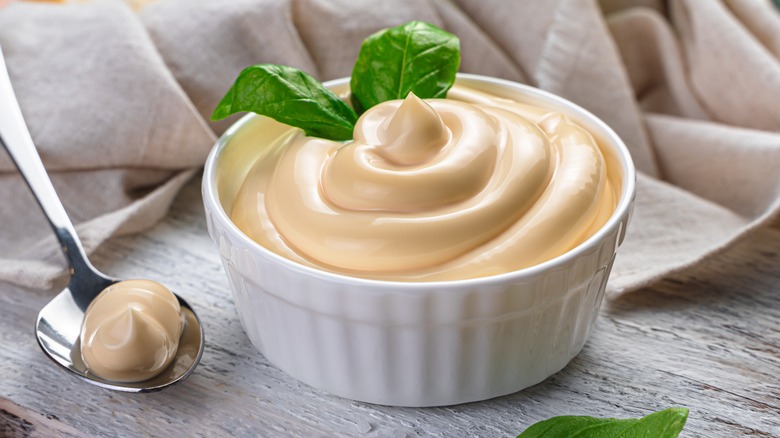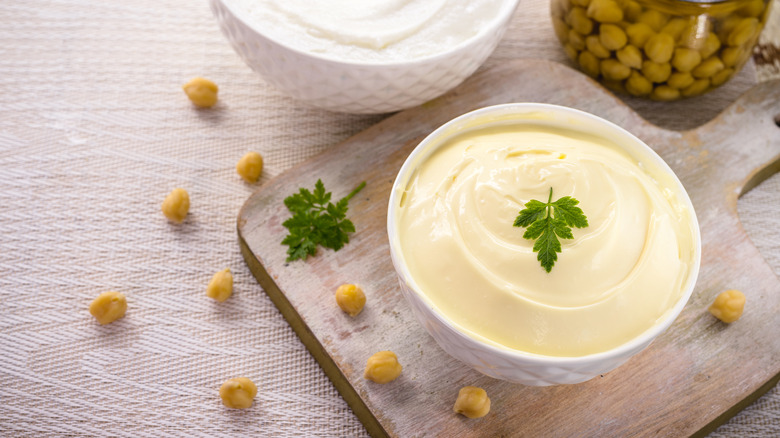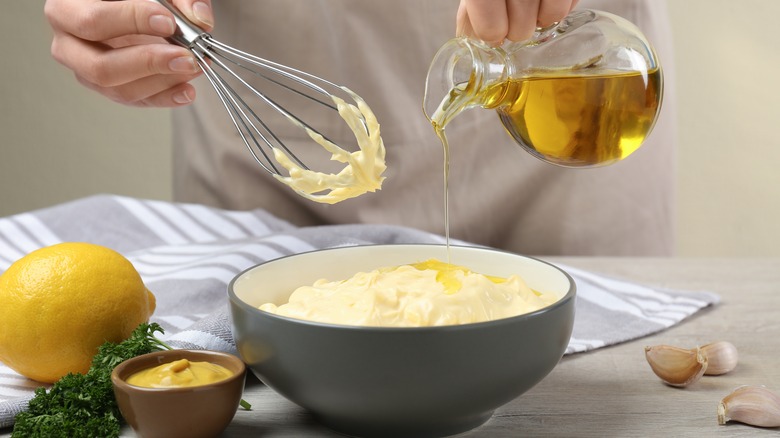Is It Possible To Make Mayo Without Eggs?
Cooking is often likened to a careful balance of chemistry, and you only need to look at creamy mayonnaise to see why that is so. At its core, mayo is an emulsion; that is, it's made from two ingredients — water and oil — that don't blend unless there's an emulsifier to help them. Egg yolks are the watery component of mayonnaise (along with vinegar), but they also bring lecithin to the mix, an essential emulsifier that binds the water and the oil together into one homogeneous sauce.
Taking eggs out of the equation and substituting them with another ingredient can throw the precise science off-kilter, but that doesn't mean it can't be done. Unlike some substitutions where you would want to mimic the flavor or texture of an ingredient, replacing eggs in mayo requires an alternative that can replicate its chemistry. Luckily, there are some ingredients that rise to the occasion — particularly chickpea water (aka aquafaba) and soy milk.
Aquafaba is a trusty staple for egg-free baking, especially for its spectacular ability to mimic whipped egg whites. What makes it even better is that aquafaba is an excellent emulsifier, which is why it can be an effective base for mayo in place of eggs. The same goes for soy milk: It can replicate the stabilizing and emulsifying properties of eggs to some extent, making it a fine base to use for egg-free mayonnaise.
Mayo can be made vegan with clever substitutes
While aquafaba and soy milk are among some of the best egg substitutes for plant-based mayo, they aren't the only ingredients that can be used. Cashews, often used to make vegan cheeses, sauces, and desserts, can also be used to make eggless mayo. As long as you use raw, unsalted cashews and soak them for about 30 minutes in warm water until they soften up, the high fat content of the nut will help it blend into a thick and creamy mayonnaise. Silken tofu is another base that can be used instead of eggs, as its soft, smooth, and fluffy puree emulsifies excellently with oil.
Making mayo without eggs can also be as easy as blending acids and seasonings with cooked vegetables instead of yolks. Roasted eggplants, beans, artichokes, and spinach can all be used as the base for egg-free mayo, as can plain white bread along with some water. The only thing to bear in mind when using these is that cooked vegetables don't emulsify as easily as aquafaba, soy milk, or even tofu, so you may need to add a little bit of lecithin powder to help the process. That said, it's worth noting that the mustard, which gives mayo its zing, is also one of the best natural emulsifiers, so adding even just that will help blend the eggless mayo to some extent.
Tips to make mayo without eggs
Making mayo without eggs is fairly easy, but a few tips will go a long way in ensuring that it comes out perfect, especially if you run into trouble while emulsifying it. For one, no matter how you choose to blend it — in a food processor, using a hand blender, or with a good ol' whisk — make sure to pour the oil into your egg substitute slowly, and in very small quantities at a time. This makes it much easier to emulsify the mayo. Emulsion is also easier when all your ingredients are at room temperature, so wait for the aquafaba and cooked veggies to cool down, or for the refrigerated soy milk and tofu to warm up.
The proportion of oil to the egg substitute matters, too. If you're using soy milk, for example, using more oil than milk will make the mayo runnier. Though ideal for salad dressings, you might find it too liquidy for dips. A runny mayo will also separate quicker, so unless you want to re-emulsify it before each use, you should use it up as soon as possible. On the flip side, mayo with equal amounts of oil and soy milk will be on the thicker side and stay emulsified for much longer. Once you have your proportions down, feel free to season the mayo to your liking — salt, pepper, paprika, garlic, hot sauce, or even a pinch of turmeric for color, anything goes!



